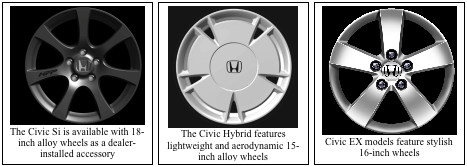
Overview
Honda has a legendary reputation for making its vehicles fun-to-drive with precise steering and responsive suspension tuning with refined road manners. Precise and sharp handling performance also contributes to accident avoidance maneuverability - one of the key reasons Honda pays so much attention to handling performance. The 2006 Honda Civic chassis delivers higher levels of sportiness and ride comfort with improvements in three key areas - enhanced suspension geometry with larger wheels and tires, a longer wheelbase, and a new generation 4-channel anti-lock braking system (ABS). The changes add up to a new Civic that is even more responsive and sporty in demanding situations while also maintaining a smooth and comfortable ride. The potent Civic Si takes handling performance to a new extreme and demonstrates the potential of the Civic platform.
Chassis Summary
All Models
- Control-Link MacPherson Strut Front Suspension with improved caster angle and toe-control dynamics
- Multi-link compact double wishbone suspension with improved damper size and location
- Wider track for sedan (+1.3 inches front/+2.5 inches rear)
- Wider track for coupe (+1.1 inches front/+2.1 inches rear)
- Advanced Logic 4-channel ABS System
Civic Si
- High performance springs, dampers and sway bars (front and rear)
- Larger 17-inch alloy wheels (+1 inch)
- Michelin Pilot HX 215/45 R17 tires
(Michelin Pilot Exalto PE2 high performance summer tire package available)
- Large 11.8-inch ventilated front disc brakes, 10.2-inch solid rear disc brakes
Civic Hybrid
- 15-inch lightweight and aerodynamic alloy wheels
- Low rolling resistance P195/65 R15 tires
Civic Sedan and Coupe
- Larger 16-inch wheels on LX and EX (alloy on EX), 15-inch on DX
- Larger P205/55 R16 tires on LX and EX, P195/65 R15 on DX
- 4-wheel disc brakes on EX
MacPherson Strut Front Suspension
The MacPherson strut front suspension incorporates new geometry with a high caster angle, and inversely wound springs for straight line stability, along with improved toe-control dynamics for sharp and responsive steering. To improve steering rigidity, and reduce friction, the steering gear box was mounted lower. Significant changes to steering angles, bushings, material rigidity, and spring and shock tuning result in amazingly linear suspension movement at the upper limit of vehicle dynamics and flatter cornering. When cornering, the inner wheel remains closer to perpendicular (relative to the ground plane) throughout a greater range of travel, which improves tire adhesion. To improve ride comfort, the compliance angle on the lower control arm was optimized to transmit less harshness. Further enhancements include less center offset with the wheel to minimize the potential for torque steer and shimmy (i.e. the tires' ability to transmit pavement irregularities into the suspension).

Honda engineers have also revisited the rear suspension to improve the Civic's handling precision and ride. The multi-link double wishbone rear suspension benefits from a new design that facilitates more rebound stroke and improved positioning of the damper. The improved rebound stroke allows the vehicle to soak up bumps and harsh road surfaces with quietness and ease, while also enhancing overall stability. The damper is mounted closer to the wheels for a more favorable 1.1:1 lever ratio between suspension movement and the distance that the damper actually travels (the previous ratio was 1.7:1). The more direct relationship means the dampers are able to provide better damping and control throughout the full range of suspension travel. These enhancements combined with sport-oriented spring and damper settings greatly increase the overall sporty feel of the vehicle and increase the feeling of coordination between the front and rear suspensions (a surprisingly uncommon trait in many vehicles).
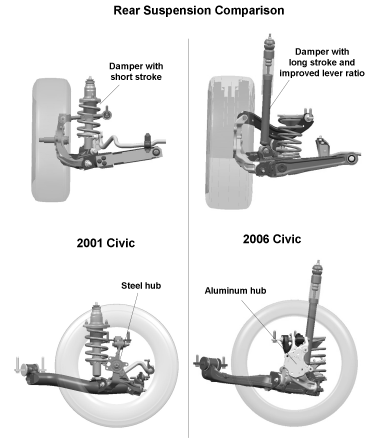
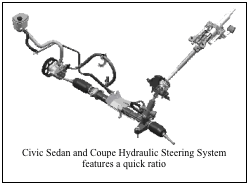 Steering System
Steering System
The variable speed sensitive rack-and-pinion power steering system features quick gear ratios for sharp and rapid transitions. Previously a high-mounted steering box, the entire steering system is located lower in the vehicle to improve input geometry into the front suspension for a more direct feel. The Civic Si and Civic Hybrid feature a sport-oriented speed sensitive Electric Power Steering (EPS) that increases power assist at low speeds and reduces power assist at high speeds. The Civic Coupe and Civic Sedan use a speed sensitive hydraulic power steering system. All models have a tilt and telescope steering wheel. The turning circle (diameter) is 35.4 feet, curb-to-curb for Civic Sedan and Civic Coupe, 34.8 feet for the DX and Hybrid, and 35.6 feet for the Si coupe.
Steering Ratios: Civic Si 13.62:1 / Civic Hybrid, Civic Sedan and Coupe EX, LX, DX 13.73:1
Turns, lock-to-lock: Civic Si: 2.65 / Civic Hybrid, Civic Sedan and Coupe EX, LX, 2.67 / Civic DX 2.73
Braking System with Advanced Logic 4-Channel ABS
All Civics are equipped with a new 4-channel ABS with Electronic Brake Distribution (EBD). Disc brakes are used on the front and rear wheels on Si and EX models; rear drum brakes are used on Hybrid, LX and DX models.
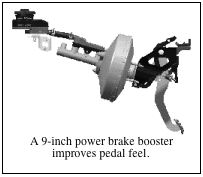 The 4-channel ABS with EBD independently modulates braking power at each wheel, as opposed to the more common 3-channel system that modulates the front wheels independently and the rear wheels with equal braking force. The new 4-channel capability allows the rear wheels to react independently while cornering, representing a significant enhancement to the ABS system's ability to influence vehicle stability and safety. Electronic Brake Distribution proportions brake power to the rear wheels based on vehicle weight distribution. Further additions to the braking system include a new ABS control module (that applies the new 4-channel features) and a relatively large 9-inch power brake booster that improves pedal feel. Higher pedal rigidity with a decreased pedal stroke provides a more immediate braking response. Bottom line, the Civic stops with greater authority and added control.
The 4-channel ABS with EBD independently modulates braking power at each wheel, as opposed to the more common 3-channel system that modulates the front wheels independently and the rear wheels with equal braking force. The new 4-channel capability allows the rear wheels to react independently while cornering, representing a significant enhancement to the ABS system's ability to influence vehicle stability and safety. Electronic Brake Distribution proportions brake power to the rear wheels based on vehicle weight distribution. Further additions to the braking system include a new ABS control module (that applies the new 4-channel features) and a relatively large 9-inch power brake booster that improves pedal feel. Higher pedal rigidity with a decreased pedal stroke provides a more immediate braking response. Bottom line, the Civic stops with greater authority and added control.
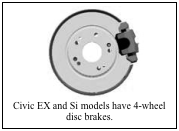 Front and Rear Brakes
Front and Rear Brakes
Civic Si
High performance stopping power is provided by a robust front and rear disc brake system on the Civic Si that provides short stopping distances and enhanced resistance to fade. The Civic Si uses 11.8-inch high-performance ventilated discs in front (0.40-inch rotor width) and 2-piston high performance calipers. Supplemental fresh air front brake cooling is received via an aerodynamic strake positioned in front of the tire. The strake directs fresh air across the rotors for cooling much like a dedicated brake duct, allowing the brakes to be more resistant to fade in demanding high frequency and high performance stopping situations. The rear disc brakes are 10.2-inch solid discs (0.35-inch rotor width) with single piston calipers.
All Models (Except Si)
Civic Hybrid, EX, LX and DX models are equipped with 10.3-inch ventilated front discs (0.4-inch rotor thickness) and double piston calipers. The braking systems on all models were engineered to provide enhanced brake feel and improved performance. TheCivic EX trim level has rear 10.2-inch discs (0.35-inch rotor thickness) with single piston calipers. Civic Hybrid, LX and DX models use 7.8-inch rear drum brakes. Additionally, the Civic Hybrid's hydraulic brake booster electronically cooperates with the Engine ECU to provide optimum regenerative braking.
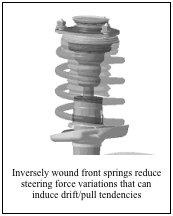 Springs, Dampers and Stabilizer Bars
Springs, Dampers and Stabilizer Bars
The tuning of the suspension is designed to minimize front-end dive during braking and squat under acceleration, as well as reduced body roll when cornering. The spring rates, combined with precision damper tuning, provide a good balance between its fun-to-drive character and everyday ride comfort.
As with every vehicle that utilizes a front strut suspension design, the strut bears the load of the weight of the vehicle. Drive forces during the suspension's compression stage can sometimes influence steering precision because as the springs compress, they exert torsional force in the opposite direction on the steering mechanism and sometimes make the car pull to the side. To neutralize this effect, Honda engineers applied inversely wound (wound in the opposite direction) coil springs to the front struts. Because the two front springs compress in opposite directions, the torsional force they produce cancels each other out, minimizing their effect on steering.
Damper construction is a progressive valve design that significantly contributes to a smooth ride and precise handling characteristics. These gas-pressure dampers use a stacked disc-valve arrangement that yields easily and progressively to high-velocity damper piston movement, such as those created by bumps and road impacts; however, the same velocity-sensitive valves present more resistance to the small, low-velocity movement associated with body transient motion at high speed.
All models (except for the DX) feature front and rear stabilizer bars to reduce body roll during cornering. The diameter of the front stabilizer bar on non-Si models measures 24.2 mm (tubular with a wall thickness of 3.0 mm). Solid rear stabilizer bars on non-Si models measure 10 mm.
Civic Coupe Exclusive Suspension Tuning
To achieve sport coupe performance, the Civic Coupe has the following exclusive suspension tuning compared to the 2006 Civic Sedan:
- Front spring rate increases 20 percent
- Rear spring rate increases 28 percent
- Sport tuned front and rear damper settings
- Solid front 25.4 x 3.5 mm tubular stabilizer bar (up from 24.2 x 3.0 mm)
- Solid rear 11.0 mm stabilizer bar (up from 10.0 mm)
Civic Si Exclusive Suspension Tuning
To achieve razor-like performance, the Civic Si has the following exclusive suspension tuning compared to the 2006 Civic Coupe:
- Front spring rate increases 17 percent
- Rear spring rate increases 14 percent
- Track tuned front and rear damper settings
- Solid front 28.0 mm stabilizer bar (up from 25.4 mm tubular)
- Solid rear 17.0 mm stabilizer bar (up from 11.0 mm)
- Heavy duty front wheel hub and bearings
- Heavy duty front and rear lower control arms
Civic Hybrid Exclusive Suspension Tuning
The Civic Hybrid has the following exclusive suspension tuning compared to the 2006 Civic Sedan that optimizes the vehicle's unique specifications:
- Solid rear 12 mm stabilizer bar (change from 10 mm)
Wheels and Tires
Larger wheels and tires contribute to the Civic's enhanced ride and handling. The Civic Si is available with Michelin's new Pilot Exalto PE2 ultra high performance tire in size P215/45 R17 (factory option) and 17x7 inch alloy wheels. A dealer installed 18-inch wheel and tire package is available.
The Civic Hybrid features P195/65 R15 low rolling resistance tires with lightweight and aerodynamic 15x6 inch alloy wheels. The LX and EX trim levels for sedan and coupe have P205/55 R16 tires and 16x6.5 inch wheels (the EX has alloy wheels and the LX has steel wheels with covers). The DX sedan and coupe ride on P195/65 R15 tires with 15x6 steel wheels with covers. A space saver spare tire is stowed under the trunk floor.
